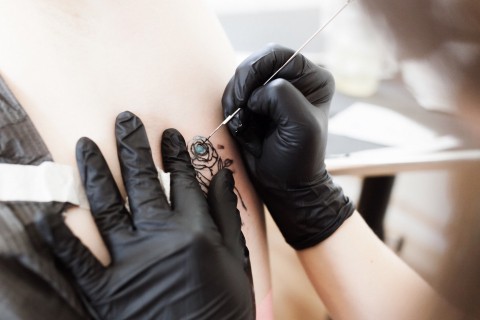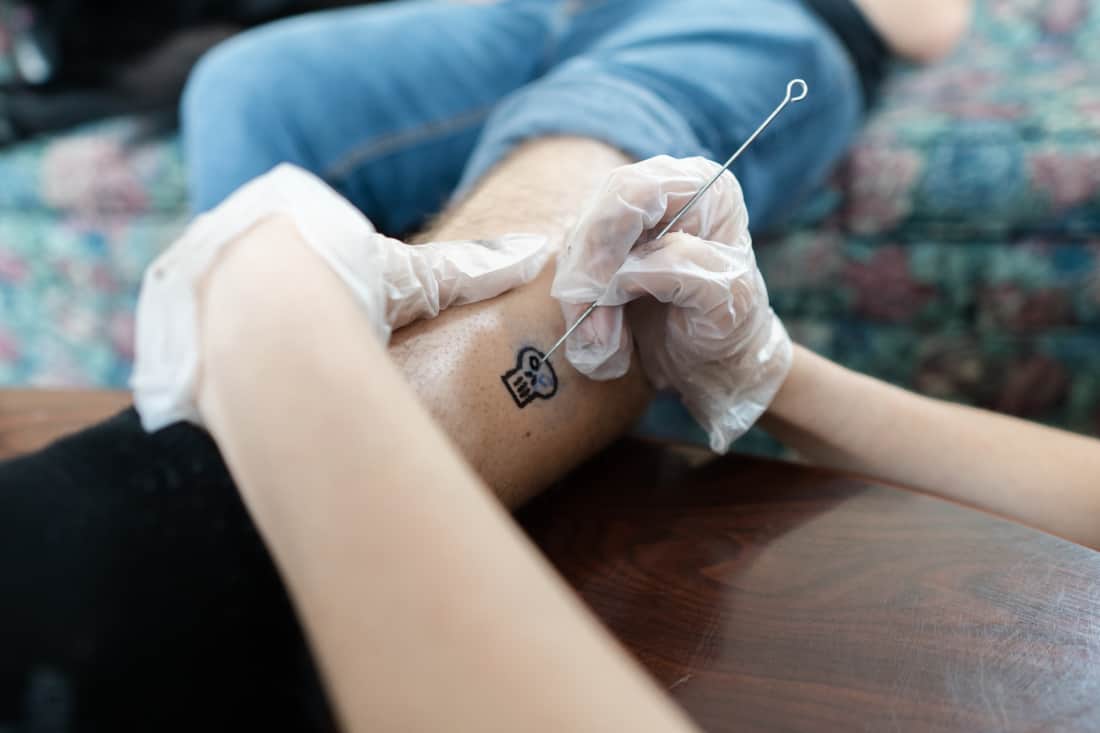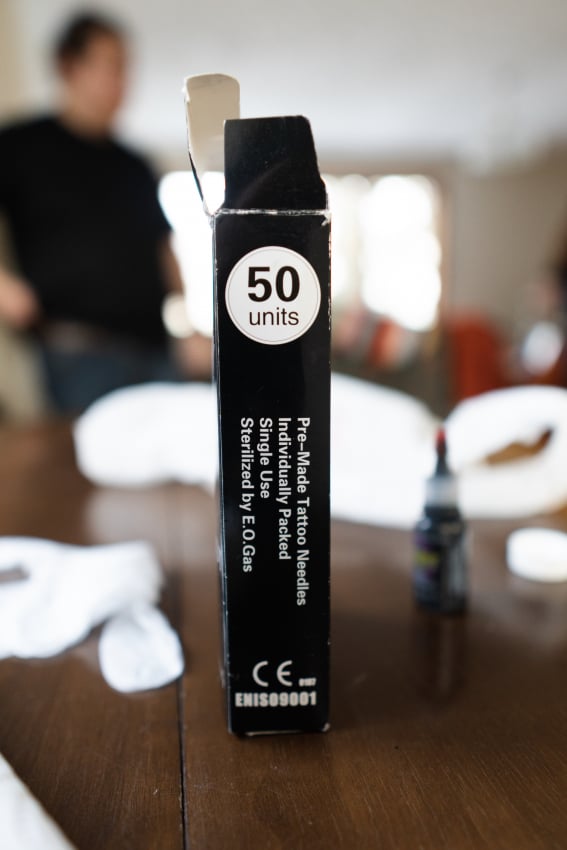They say tattoos are for forever — and stick-and-pokes are no different. However, there is a major difference as amateur ink can leave you with an infection that — while not necessarily permanent — you will regret more than a poorly drawn Pikachu.

But what are the best practices for doing a stick-and-poke? This question drove me to investigate first-hand experiences from students and find answers on how to avoid infection. Jessica Quan, a first-year law student, says that she got her stick-and-poke on a whim the day before her English 110 final.
“I was studying with my friends, and one of my friends was like, ‘Hey, does anyone want to do stick-and-poke tattoos?’ Then, we all proceeded to get stick-and-pokes in her basement,” Quan said, in an email to the Sheaf. “I find that I get tattoos and piercings when I’m at my peak points of stress. I think it’s because I want to feel something other than the dread of writing finals.”
While Quan acknowledges that the sanitary precautions they took “definitely weren’t at that level,” as in the level of a tattoo shop, she is still confident that their methods were safe in terms of avoiding infection.
As to why she went with a stick-and-poke rather than booking an appointment with a shop, Quan shared a reason that seems to be at the core of the culture of sticking and poking — impulsivity.
“With regular tattoos, there’s planning that goes into it whereas my stick-and-poke was completely out of impulse. I probably would have never gotten my stick-and-poke design professionally done by a tattoo artist,” Quan said.
While the common image related to hand-poked tattoos is one reminiscent of a bunch of friends in a basement — oftentimes less than sober — there are those who have sought to bring this method to a professional space. One such example is Savannah Holt who runs Of The Woods — a business were she tattoos customers without the use of a gun.

In addition to this endeavour, Holt is also a community educator at Saskatoon Sexual Health where she has given a safe tattoo practice seminar for youth in addition to various other projects, such as overseeing the Wrap It Up condom campaign. Holt gives an explanation for her decision to go without a tattoo machine.
“Initially, I had no goal or ambition to make tattooing a career. I had applied for grad school, was working at a bar, and during a ‘sober November,’ I was feeling a bit bored,” Holt said, in an email to the Sheaf. “I’d noticed on Instagram that hand-poke tattoos were having a renaissance, asked around Regina to see if anyone I knew was doing them, and the ones I did see were kind of what you’d expect when you think ‘stick and poke.’”
Holt explains that the results she saw “weren’t done very well” and that she had concerns about the health risks involved — which prompted her to look into the practice.
“I decided to do a lot of research, sourced some sterile tools and gave it a go myself. The first ones I did healed really well, and it’s been a bit of a snowball effect ever since then. I enjoy it, so I keep doing it,” Holt said.
Having made a career out of stick-and-poke tattoos, Holt also spoke to the difference between tattoos done with a machine versus hand-poked tattoos in a professional setting.
“Hand-poke tattoos will often have more texture, will take longer to finish, and very often, they are much less painful than machine tattoos as they cause less trauma to the skin,” Holt said. “While all tattoos may fade over time and there are individual skin differences that may affect the final tattoo, hand-poke should last just as long as a machine tattoo if done properly using the same tools as a machine artist, sans the motor itself.”

On the topic of hand-poking at home, however, there is the issue of proper sanitation, which is often a source of risk and concern. Holt gives her opinion on tattooing at home.
“I can’t judge too much on this because that is how I started tattooing as well. However, I do know that most people who choose to tattoo themselves at home likely aren’t educating themselves on all of the risks related to blood-borne infections, complications and environmental health issues, so my first instinct is to cringe,” Holt said.
All this being said, however, there’s no real way to truly keep people from getting tattoos done outside of a shop, and Holt believes that the only steps to take are to minimize the potential risks.
“I’m passionate about harm-reductive education,” Holt said. “We can’t stop everyone from doing risky things like tattooing themselves at home, so how can we educate them to make sure they are doing it properly and in a way that will minimize the risks of disease transmission and infection?”
While the focus on sanitation may be on the needle because it’s actually going into your skin, the environment in which the tattoo is being given is also important, as Holt explains.





“If the space you’re tattooing in isn’t pristine, then contaminants, bacteria, viruses, etc. can potentially be introduced into your ‘sterile’ workspace,” Holt said. “If you’re tattooing on a surface that cannot be wiped down with a cleaner like CaviCide, then it will instead harbour all the not-so-fun-stuff that might cause a serious infection — particularly if it comes into contact with any blood droplets or other body fluids.”
The equipment being used plays a major role in ensuring a safe and infection-free tattoo. Holt explains that a healthy amount of research should be conducted before going through with the tattoo and shares some of the core pieces of equipment that are needed. These include single-use sterile tattoo needles, non-toxic ink such as India Ink, paper towels, antibacterial soap — like Dr. Bronner’s — and single-use ink caps.
Holt stresses the single-use aspect of the needles, stating that you should never share needles under any circumstances. Expanding on the equipment needed for safe at-home tattooing, Holt shares some other necessary equipment that may not immediately come to mind.
“The last super important parts of that at-home puzzle are nitrile gloves and Saran Wrap. Do not touch anything you’ll be working with until you’ve washed your hands and put on gloves,” Holt said. “Make sure the surfaces you’ll be sitting on or setting up on are wipeable with a high-grade cleaner, and make sure you put a bunch of paper towels and Saran Wrap underneath the area you will be working on after you’ve cleaned the hot heck out of the place.”
Lastly, Holt shares a final piece of advice regarding the cleanliness of equipment.
“If something falls on the floor, it’s dead to you. Do not use it. Do not try cleaning it and using it. Leave it there, and throw it away when you’re done. It’s a good thing you’ve ordered all those extra supplies designed for tattooing because you can now replace whatever fell on the floor with something sterile.”
Stick-and-poke tattoos are a form of self-expression, but an infected mess is not what most people would like to express on their skin. So the next time you or one of your friends is looking to get some homemade ink — make sure your best is done to ensure the health of all involved.
—
Jack Thompson / Sports & Health Editor
Photos: Riley Deacon / Photo Editor